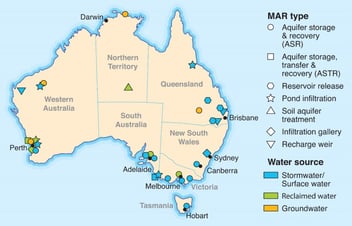Australian exemplars of sustainable, economic managed aquifer recharge
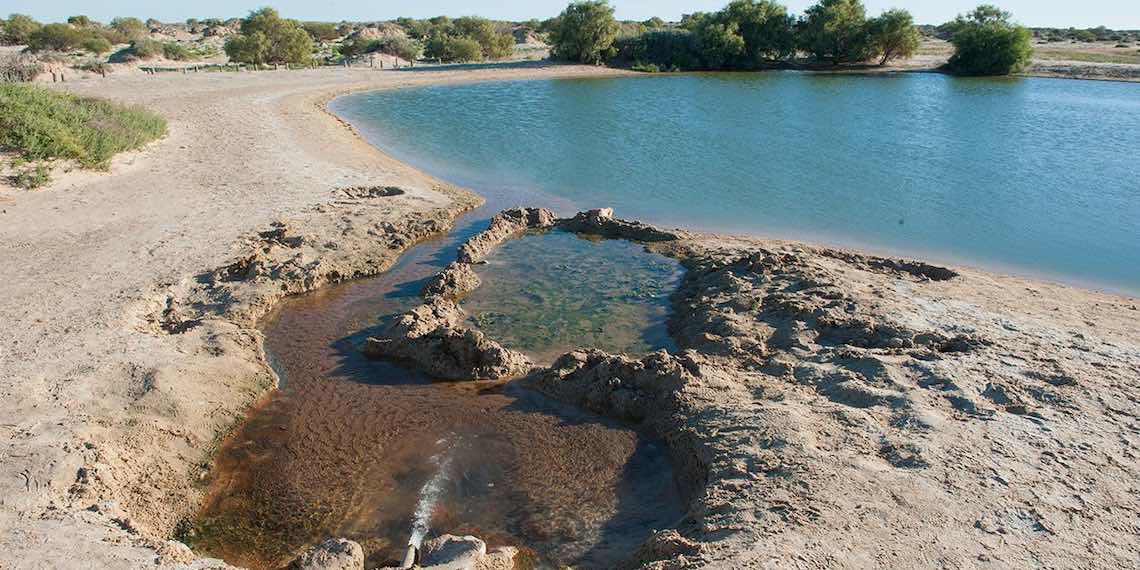
First published in Water e-Journal Vol 5 No 4 2020.
Ensuring water security and resilience for the future
DOWNLOAD THE PAPER
Abstract
Managed aquifer recharge (MAR) can improve water security by using aquifers to store water when it is abundant until required for future use and can increase the use of urban stormwater and treated wastewater to reduce the demand on traditional surface water and groundwater supplies.
Recently, two Australian examples were showcased internationally as sustainable and economic MAR: Perth’s groundwater replenishment scheme (GWRS) with recycled water to increase security of urban water supply and a multi-site urban stormwater MAR scheme for suburban non-potable water supply in Salisbury, Adelaide. This paper provides a synopsis of these Australian exemplars of sustainable and economic MAR.
Novel environmental and social sustainability indicators highlighted the importance of implementation in accordance with the Australian MAR Guidelines. Both Australian examples were deemed to be at a good standard for sustainability due to compliance with this rigorous risk-based guidance for protecting health and environment.
Perth’s GWRS reported a levelised cost of AU$1.74/kL (US$1.29/kL at 2016 costs) and a benefit cost ratio of 1.5, as the cost of groundwater replenishment is lower than that for an additional seawater desalination plant of the same capacity. Public open space irrigation using stormwater MAR at Salisbury had a levelised cost of AU$1.32/kL (US$0.98/kL at 2016 costs) and a benefit cost ratio of 2.5 when compared to the lowest cost alternative (irrigation with mains drinking water supply).
The initiating organisations understood the importance of research and investigation, in addition to risk-based monitoring and management. These helped to ensure health and environmental protection, underpinning these developments.
Introduction
Managed aquifer recharge (MAR), or intentional groundwater replenishment, is a means of improving water security by using aquifers to store water when it is abundant until required for use. When coupled with water recycling, MAR can increase the use of urban stormwater and treated wastewater to reduce the demand on traditional surface water supplies, or to augment groundwater supplies.
Since the 1960s, there has been considerable growth in MAR to now recharge approximately 10,000 GL/year globally. Despite this growth, MAR or groundwater replenishment equates to only an approximate 2.4% of groundwater use in the countries that practice MAR (Dillon et al., 2019). In Australia, MAR of approximately 410 GL/year represents 8.3% of groundwater use.
In addition to storage of available surface water and groundwater, Australia has experience in harvesting urban stormwater, recycled water, and pumped mine or coal seam gas water, for use or to provide environmental benefit (i.e. sustaining groundwater dependent ecosystems) (Figure 1).
A growth rate in MAR in Australia (3.6%/year) slightly below the global average (4.9%/year), coupled with recharge of less than 10% of groundwater use suggests there is potential to increase the use of MAR to replenish over-exploited groundwater systems, in conjunction with demand management. Longer-term water banking for drought or emergency response is an emerging application of MAR, which has considerable potential within Australia (Dillon, 2015; Funnell, 2020; Gonzalez et al., 2020).
Water banking has been successful in the USA, where a scheme in California accumulated 1,100 GL over 20 years which was used for water supply during significant drought (Gonzalez et al., 2020). While MAR in Australia has largely focused on short-term seasonal water supply, a recent evaluation of water banking potential in Australia’s Murray-Darling Basin reported the capacity to bank multiple years of irrigation supply (Gonzalez et al., 2020).
Barriers to the uptake of MAR include uncertainty related to technical feasibility in various hydrogeological settings, economic viability, and compatibility with water resource management policies. Measures to address this uncertainty and support further growth in MAR include documentation of exemplary case studies, guidelines for development and operation of MAR schemes which provide guidance for health and environmental protection and increased knowledge of the costs and benefits of MAR operations (Dillon et al., 2019).
Currently, Australia is the only nation to adopt guidelines for risk-based management of MAR to provide protection of human health and the environment. These are the Australian Guidelines for Water Recycling: Managed Aquifer Recharge (“MAR Guidelines”) (NRMMC-EPHC-NHMRC, 2009). The MAR Guidelines can be applied to any source of water for recharge, any aquifer type, any recharge method and any end-use of the stored water, while addressing management of water quantity and quality. The MAR Guidelines are underpinned by pragmatic scientific understanding, which has been gained through decades of research and investigations that accompanied the development of Australia’s MAR capacity.
Recently two Australian MAR operations (Higginson et al., in press; Naumann et al., in press) were included as part of 28 examples of MAR encompassing applications from a village to state level (Zheng et al., in press). These examples assist with overcoming impediments to MAR by including practical experience from conception to realisation, benefit cost assessment (Ross, in press), and a novel assessment of sustainability based on a suite of sustainability indicators addressing environmental and social sustainability. These indicators were developed due to the absence of suitable indicators for application to MAR, and addressed resource integrity, impacts on ecosystem services, energy intensity, regulatory frameworks and public consultation (Zheng et al., in press).
In Western Australia, Perth’s GWRS with recycled water to increase the security of urban water supply as well as in South Australia, the City of Salisbury’s multi-site urban stormwater MAR, which supports suburban non-potable water supply, are documented examples. In Australia, stormwater drainage systems are separate from sewerage systems which means that treated wastewater and urban stormwater can both be a source of water for MAR.
These case studies serve to build confidence in MAR by using alternative water supplies for both potable and non-potable end uses. The success of both MAR operations is underpinned by investment in research and investigations, along with risk-based monitoring and management to ensure health and environmental protection. This paper provides a synopsis of these Australian exemplars of sustainable and economic MAR.
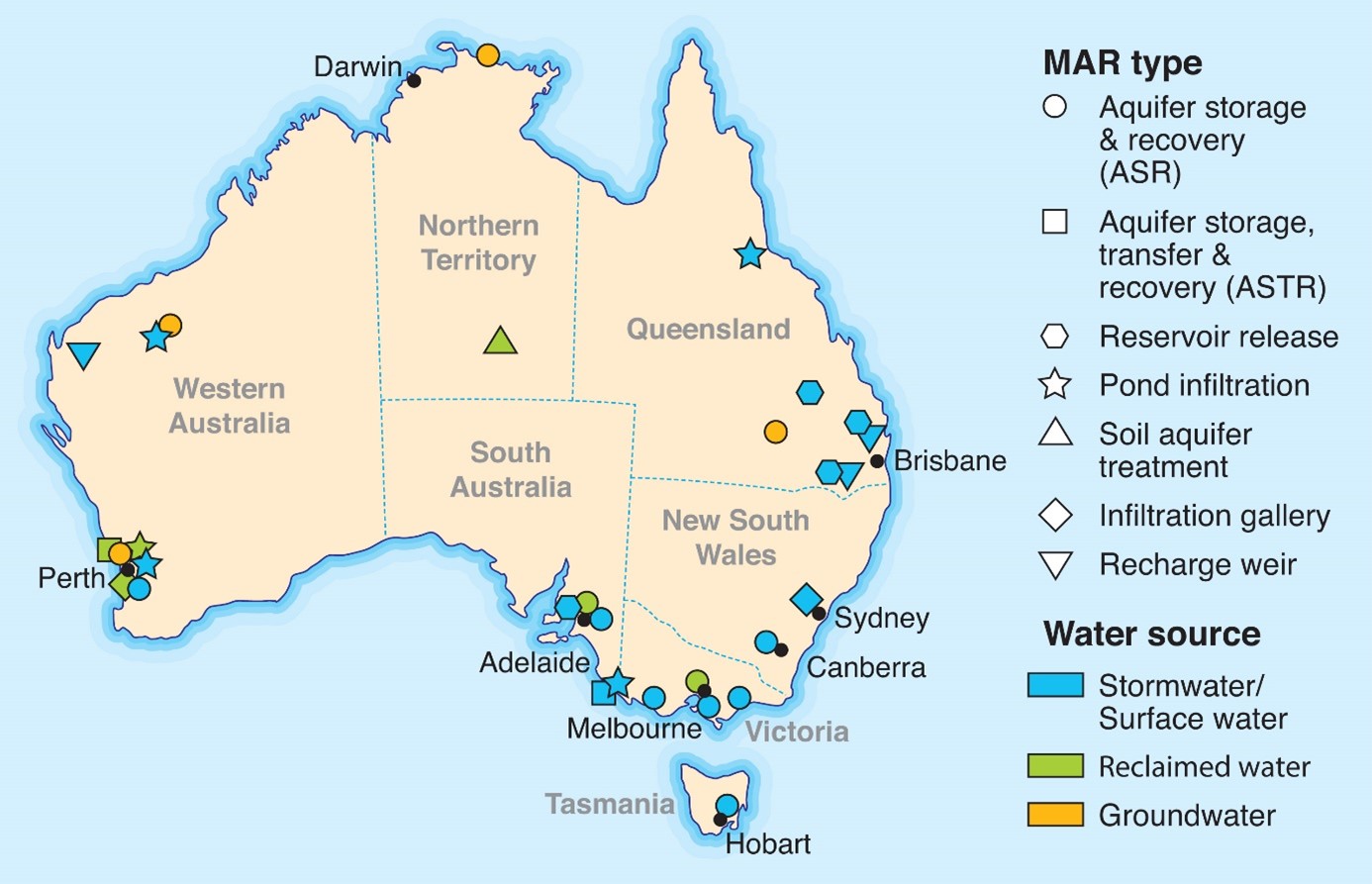
Figure 1. An overview of Australia’s extensive capacity for MAR using surface water, urban stormwater, recycled (reclaimed) water and groundwater (including pumped mine and coal seam gas water) (modified after Dillon et al., 2009).
Methodology
MAR refers to the intentional recharge of water to aquifers for subsequent recovery or environmental benefit (NRMMC-EPHC-NHMRC, 2009a). This paper presents examples of well injection techniques for MAR targeting confined aquifers, including aquifer storage and recovery (ASR), which uses a single well for recharge and recovery; and aquifer storage transfer and recovery (ASTR), which uses separate wells for injection and recovery.
Operators of Australian MAR, including Western Australia’s Water Corporation, and South Australia’s Salisbury Water, a business unit of the City of Salisbury in Adelaide, shared their experience with treated wastewater and stormwater MAR (Table 1). Documentation of MAR exemplars included a detailed description of the scheme, motivation and history of development, the approval process, and costs and benefits.
Nine sustainability indicators were developed to assess environmental (n=6) and social (n=3) sustainability due to the absence of existing indicators for application to MAR (Zheng et al., in press). The environmental indicators addressed resource integrity with respect to water quantity and quality (n=4), impacts on ecosystem services (n=1), and energy requirements as the key stressor (n=1). The social sustainability indicators were based on regulatory arrangements to protect resource security and human health (n=2), and institutional arrangements for public and stakeholder consultation (n=1).
The economic assessment was based on levelised cost and benefit cost ratio of MAR scheme development in relation to the next best alternative source of water. To allow for comparison, all costs were standardised to 2016 values. Levelised cost per kilolitre was calculated using a present-value analysis and determined from the constant level of revenue necessary each year to recover all the capital, operating and maintenance expenses over the life of the project, divided by the annual volume of water supply provided by the MAR scheme. Benefits assessed included the avoided cost of the cheapest alternative water supply option. Social and environmental benefits were not assessed for the MAR examples, however had previously been reported for the Salisbury scheme (Dandy et al., 2013; Dandy et al., 2019).
Perth’s groundwater replenishment with recycled water
Perth’s GWRS is an essential component of Water Corporation’s strategy to improve long-term water security for the city. Advanced treated wastewater is recharged to confined sandstone aquifers via wells for later use as a drinking water source. With separate recharge and extraction bores, the GWRS is an example of water banking via ASTR with anticipated decades of residence time in the aquifer prior to recovery for use. Recovered groundwater is treated prior to use via the Perth Integrated Water Supply Scheme. This groundwater treatment includes aeration, water softening, pH adjustment, filtration, chlorination and fluoridation. The MAR operation provides a safe, climate-independent drinking water source for Perth.
The GWRS has a capacity of 28 GL/year, with Stage 1 commencing recharge in 2017 (14 GL/year) and Stage 2 commencing in 2020 (additional 14 GL/year). Secondary treated wastewater undergoes advanced treatment by ultra-filtration, reverse osmosis and UV disinfection prior to recharge (Figure 2). Stage 1 consists of four recharge bores and four monitoring bores up to 745 m below ground level. Stage 2 duplicates the advanced water treatment capacity, adding four recharge and four monitoring bores up to 1400 m below ground level, and a 13 km pipeline to deliver recycled water to the recharge bores.
Groundwater replenishment with recycled water is considered to have the potential to provide up to 20% (115 GL/year) of Perth’s projected water supply portfolio (550 GL/year) by 2060 (Water Corporation, 2009; Water Source, 2018).
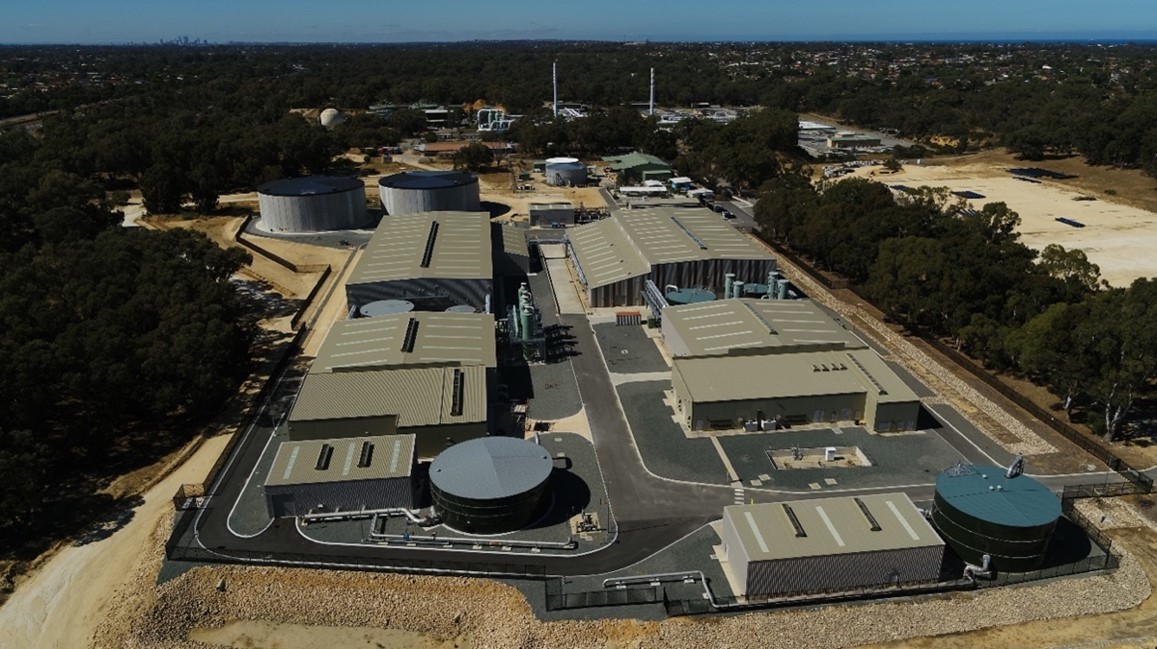
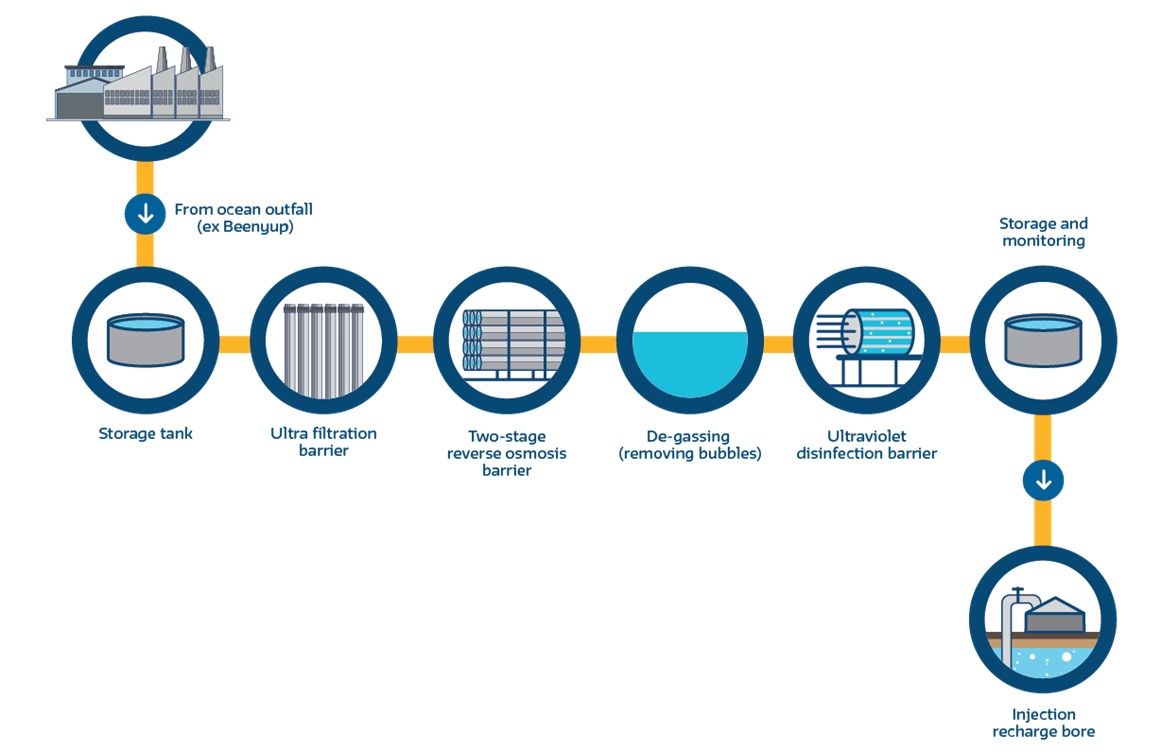
Salisbury’s multi-site urban stormwater MAR
Salisbury Water uses ASR and ASTR to store wetland treated urban stormwater in confined limestone aquifers and provides a sustainable water supply that is distributed to customers via a dedicated non-potable ‘purple pipe’ network. The distributed water is delivered at a standard ‘fit for dual reticulation for indoor and outdoor use’ (NRMMC-EPHC-NHMRC, 2009b). The MAR operation provides a reliable ‘fit for purpose water supply’ using large scale cost-effective storage to make effective use of seasonally available urban stormwater.
The non-potable water distribution network operated by Salisbury Water is comprised of nine urban stormwater harvesting catchments or ‘hubs’ where stormwater is treated via constructed wetlands (e.g. Figure 3), 31 ASR wells, four injection only wells, 28 extraction only wells and 150 km ‘purple pipe’ reticulation network. On average 3.5 GL/year is recharged, which is approximately 20% of the average annual run-off in the City of Salisbury and 2.5 GL/year is extracted.
MAR targets Tertiary aquifers (T1 and T2) of the Port Willunga Formation, consisting of upper (T1) and lower (T2) sandy limestone aquifers separated by a 5-10 m thick confining layer of Munno Para Clay (Naumann et al. 2020). While intended for seasonal water supply, the MAR network also has the capacity for some longer-term storage to buffer climate variability.
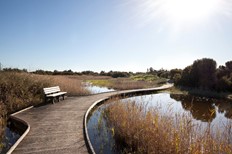
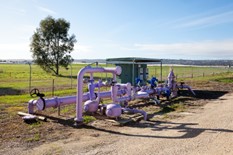
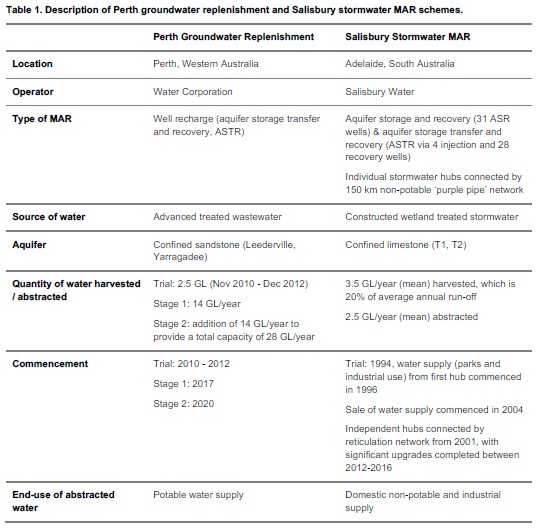
Motivation and scheme development
Perth’s GWRS and Salisbury’s stormwater MAR scheme provide improved water security for potable and non-potable water supply, respectively. In Perth, motivation for MAR came from the understanding that traditional water resources from groundwater and surface water may not be able to meet future demands due to climate variability and growth in demand. In Salisbury, the initial and ongoing driver for urban water management is for drainage and flood mitigation to protect property.
Over time, provision of drainage provided a pathway to MAR development to affordably sustain urban amenity. Salisbury implemented stormwater treatment via 70+ constructed wetlands and bio-filters to manage the environmental impact of stormwater discharge on the receiving marine environment, whilst also improving public amenity. The next step was to harvest this alternative water resource using large scale cost-effective MAR storage for non-potable water supply and reduce the financial burden of irrigating public open space with mains water.
Investigations and collaboration between private industry, government, and research organisations were integral to the development of both schemes. As the first groundwater replenishment scheme using recycled water to augment drinking water supply in Australia, extensive investigation (2007-2010) was undertaken in Perth (e.g. Descourvieres et al., 2010) prior to conducting a trial (2010-2012). This was to demonstrate the technical, social, and regulatory requirements for implementation and ongoing operation (Water Corporation, 2013).
In developing the GWRS, Water Corporation were able to learn from the documented experience of others; including Orange County Water District’s Groundwater Replenishment Scheme (>96 GL/year) (CDM Smith, 2017); and, South Australia’s recycled water ASR trial (Dillon et al., 2006). Open communication and engagement activities were integral to building community and regulatory acceptance of groundwater replenishment (Bettini and Head, 2016). Operation of Perth’s GWRS commenced in 2017 with a doubling of capacity in 2020. Funding from the Australian Government supported the development of the replenishment scheme. The trial was supported by the Australian Government’s Water for the Future initiative through the Water Smart Australia program (DAWE, 2020).
Salisbury’s first ASR trial commenced in 1994 at one of the current harvesting hubs (Paddocks ASR, capacity 0.05 GL/year) and triggered incremental development of the stormwater MAR network in parallel with subdivision for housing over multiple decades to include several hubs, a distribution network, and an expanded customer base (Naumann et al., in press; Radcliffe et al., 2017). Sale of water commenced in 2004. Funding from the Australian Government through the Water Smart Australia program was also integral in the development of Salisbury’s stormwater MAR network.
Research partnerships over two decades have addressed multiple facets of scheme development which underpin these examples of successful MAR operation in Australia. For example, targeted investigations have addressed aquifer characterisation and migration of the injected plume (Miotlinski et al., 2014; Seibert et al., 2014); the extent of mixing and its impact on recovery efficiency (Miotlinski et al., 2014); source water quality (Page et al., 2013a; Page et al., 2016) and reliability (Clark et al., 2015); geochemical processes and their impact on water quality (Descourvieres et al., 2010; Ginige et al., 2013; Page et al., 2017; Seibert et al., 2016) including natural treatment of pathogens (Sasidharan et al., 2017), organic chemicals (Alotaibi et al., 2015; Patterson et al., 2012) and nutrients (Vanderzalm et al., 2018), and the potential for mobilisation of geogenic species (Schafer et al., 2018; Schafer et al., 2020); operational trigger values for use in risk management (Gonzalez et al., 2015); the potential for biofilm and sediment formation in pipe material receiving stormwater (Gonzalez et al., 2016); and economics (Dandy et al., 2013; Dandy et al., 2019; Dillon et al., 2014b; Gao et al., 2014).
Research at Salisbury has considered the potential to further expand the customer base for this resource through domestic non-potable and potable use (Dillon et al., 2014a; 2014b). Potable water use was found to be both technically and economically feasible but has not been adopted to date at Salisbury due to institutional complications. In Perth, this was not an issue as MAR was undertaken by the public water supplier, Water Corporation.
Environmental and social sustainability
Perth’s GWRS and Salisbury’s stormwater MAR scheme performed well against the newly developed sustainability indicators, with both schemes receiving a good sustainability rating (Zheng et al., in press). The GWRS was ranked positively for all environmental indicators, with strengths in improving the resource integrity through water banking and protection of water quality. Other environmental indicators (e.g. ecosystem services and stressors) were rated as enhanced.
Salisbury’s MAR network was considered to have strengths in water quality, impacts on ecosystem services and stressors (rated as superior), and resource integrity was rated as improved. In this example, an environmental sustainability goal to protect the downstream marine ecosystem by improving stormwater quality prior to discharge provided an important pathway for urban stormwater to be viewed as an alternative water resource, and not just a drainage issue.
Both Australian examples received a superior ranking for two of the measures for social sustainability: the MAR regulatory framework; and risk-based protection of human health. Similarly, both schemes were given an enhanced social sustainability rating, based on their institutional arrangements for community engagement.
Role of risk-assessment in ensuring environmental sustainability
The high performance in relation to environmental sustainability is strongly driven by compliance with the Australian MAR Guidelines (NRMMC-EPHC-NHMRC, 2009a), which were the first international adoption of risk-based guidelines for MAR (Dillon et al., 2020). The MAR Guidelines require a comprehensive risk assessment, which addresses 12 hazards or hazardous events to human health or the environment.
Seven water quality hazards, which may be present in the source water, the groundwater or be mobilised from the aquifer, may pose a risk to human health through ingestion or to the receiving environment (e.g. aquifer, soil, crop). Four additional hazard categories address risks to the target aquifer for storage and the final one addresses energy use. A maximal risk assessment assesses these hazards in the absence of any control or preventative measures (e.g. untreated wastewater).
In the next stage, a residual risk assessment includes controls or preventative measures to ensure an acceptable risk level to health and environmental endpoints is reached. Table 2 and Table 3 summarise results of these assessments for the two case studies, adopting the format first applied by Page et al. (2010a). Examples of controls to ensure adequate risk management for each of the twelve hazard categories are provided in Table 4 for both cases (after Page et al., 2010b).
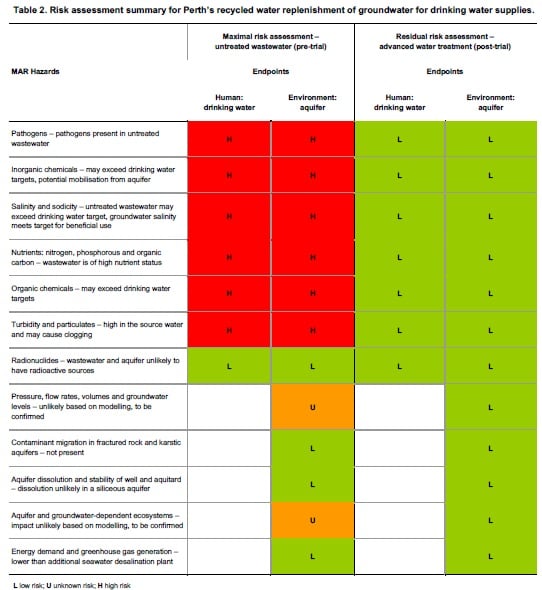
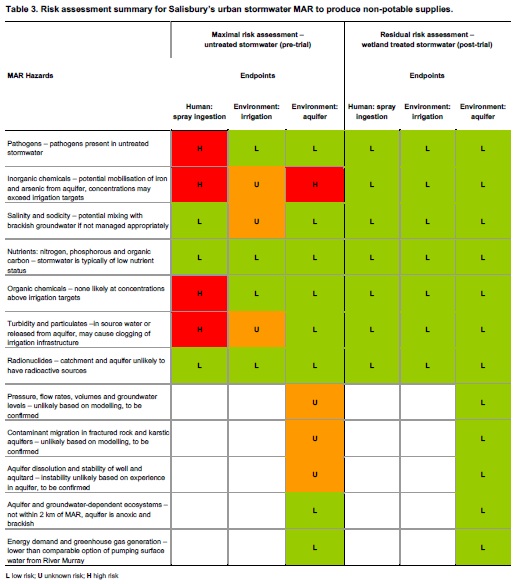
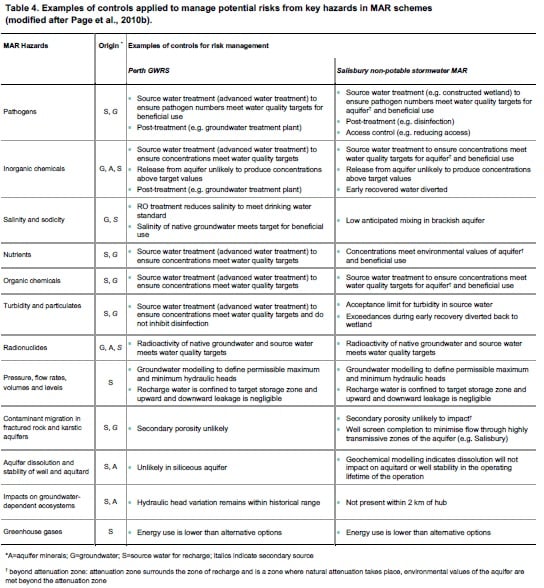
Table 4. Examples of controls applied to manage potential risks from key hazards in MAR schemes
(modified after Page et al., 2010b).
Extensive investigations have been undertaken to assess the feasibility of both MAR schemes and provide knowledge which can be applied more broadly for environmental sustainability. Extensive field, laboratory and modelling investigations in Perth have improved the understanding of aquifer reactivity and the potential for mobilisation of geogenic species during MAR (Descourvieres et al., 2010; Schafer et al., 2018; Schafer et al., 2020; Seibert et al., 2016; Sun et al., 2020), along with the fate of organic chemicals in the aquifer (Patterson et al., 2012). Deep understanding of the processes that control arsenic mobility were obtained from a reactive transport model simulating the two-year trial period (Seibert et al., 2016; Seibert et al., 2014).
Research at Salisbury has provided an understanding of the potential of urban stormwater as a drinking water supply resource (Dillon et al., 2014a; Dillon et al., 2008; Page et al., 2016); the reliability of urban stormwater supply under variable climate, which revealed that impervious urban areas are more resilient to climate change than pervious rural catchments that are subject to much greater evapotranspiration (Clark et al., 2015); and the potential for natural treatment of pathogens (Page et al., 2015; Sasidharan et al., 2017), nutrients (Vanderzalm et al., 2018) and organic chemicals (Shareef et al., 2014) in the aquifer to reduce the need for engineered water quality treatment.
Regulatory framework and risk management
As a pioneering application of MAR for indirect potable use in Western Australia, an extensive trial period coupled with extensive monitoring and model validation was crucial in developing the regulatory framework for groundwater replenishment with recycled water. The trial was used to define the approvals pathway required to develop, approve recharge, and regulate a groundwater replenishment scheme.
This regulatory framework was developed through collaboration between Water Corporation and the WA Government Department of Health, the Department of Environment and Conservation, and the Department of Water (now the Department of Water and Environmental Regulation). It defines the roles and responsibilities of each agency to ensure human and environmental health are protected. It also specifies management objectives, water quality guidelines, recharge management zone (minimum distance between recharge of recycled water and abstraction of groundwater for public drinking water supplies) beyond which environmental values are protected; and a risk assessment process guided by the Australian MAR Guidelines (NRMMC, EPHC, NHRMC, 2009). The risk assessment considers preventative measures and operational procedures, and verifies the scheme can be managed without compromising the environmental values of the aquifer.
Over 58,000 groundwater samples were collected during the initial trial (Water Corporation, 2013), and ongoing verification monitoring and groundwater modelling (Sun et al., 2020) are undertaken to ensure the groundwater quality meets all water quality targets for that aquifer at the boundary of the recharge management zone. A recharge management zone was set at 250 m around each recharge bore, and monitoring bores are located well within this zone at 50 m from each recharge bore to assess compliance.
Stormwater MAR schemes in metropolitan Adelaide are authorised by the South Australian Environment Protection Authority under the Environment Protection Act 1993 to discharge stormwater to aquifers. Licence conditions include recharge locations, maximum recharge volume per year, water quality criteria for source water, contingency planning, water quality monitoring, and reporting requirements and approval of a MAR Risk Management Plan developed in accordance with the Australian MAR Guidelines (NRMMC-EPHC-NHMRC, 2009a).
Risk-assessment and management of Salisbury’s MAR network includes assessment of injected stormwater and recovered water quality against relevant water quality guideline values (Page et al., 2010a; Page et al., 2013a); aquifer characterisation and solute transport modelling to optimise recovery efficiency of water at suitable quality for the intended use (Miotlinski et al., 2014); and, establishment of appropriate operational trigger values (Gonzalez et al., 2015) for use in risk-management (Page et al., 2013b).
Community engagement
Recognising the importance of community engagement for the success of indirect potable reuse, Water Corporation commenced engagement with the community several years prior to the trial period (Bettini and Head, 2016). A visitor centre was launched during the trial period, which assisted in improving understanding and attitudes toward the scheme. Surveys conducted during site tours in the trial period revealed that public support for the scheme increased from 74% to 93% once the community felt better informed about inherent risks and risk-management processes (Water Corporation, 2013).
Other mechanisms for community interaction included a dedicated website which included quarterly water quality reporting to the community, social media, newspapers, media releases, and presentations at community forums (Water Corporation, 2013).
Salisbury Water also conducts regular technical tours for visitors and supports a wetland volunteer group in providing community group tours. Focus group and web surveys have reported a high level of prospective public acceptance for stormwater use in third pipe residential and drinking water supply (Mankad et al., 2013). Public support and trust for stormwater use was reported as higher than for alternative water supply options of pumping from the River Murray or seawater desalination (Dillon et al., 2014a; Mankad et al., 2013). This community has experienced the social benefits of stormwater harvesting and use for multiple decades.
Economic assessment
The capital cost for Stage 1 of Perth’s GWRS was approximately AU$128M, including the advanced water treatment recycling plant and recharge and monitoring bores, which were all situated on Water Corporation property. Expansion in Stage 2 (2020) incorporates additional components and is approximately AU$294M, used to fund the duplication of the existing advanced water treatment recycling plant, recharge bores located approximately 12 km north, a pipeline to deliver recycled water to the new recharge locations, abstraction bores, and an upgrade to the existing groundwater treatment plant.
Annual operating costs of the Stage 1 advanced water recycling plant is approximately AU$4.2M. Economic analysis for Perth’s GWRS reported a levelised cost of AU$1.74/kL (US$1.29/kL at 2016 costs) and a benefit cost ratio of 1.5, as the cost of groundwater replenishment is lower than that for an additional seawater desalination plant of the same capacity.
The Salisbury stormwater MAR scheme with nine stormwater harvesting hubs has grown incrementally over two decades. The capital cost of the entire network was estimated at AU$52M and the average annual operating cost at AU$3M. Council has established an internal business unit called Salisbury Water to manage sales of all recycled water to its own parks and gardens service, industrial users, schools and other institutions, and new residential subdivisions.
As stated earlier, the Australian Government provided significant financial support (AU$28M), with additional support from the State government (AU$6M) and an industrial user to develop the MAR network under initiatives to secure urban water supply.
Economic cost benefit analysis was undertaken for one of these stormwater harvesting hubs (the Parafield catchment) and included assessment of twelve configurations for stormwater use. Only those for public space irrigation and drinking water supply had positive net economic benefits. Residential non-potable supply (third pipe options) weren’t favourable due to the cost of constructing an additional extensive distribution network.
Public open space irrigation using MAR had the lowest levelised cost of AU$1.32/kL (US$0.98/kL, at 2016 costs), which reflects the scheme as operated (Dandy et al., 2013; Dandy et al., 2019). The relative cost of MAR compared to the lowest cost alternative (using the existing mains water drinking water supply for irrigation), gave a benefit cost ratio of 2.5.
Levelised cost of the Australian examples of ASR and ASTR with urban stormwater (US$0.98/kL) and recycled wastewater (US$1.29/kL) are comparable to the average reported for well-injection schemes with recycled water (US$1.46/kL) based on international experience (Ross and Hasnain, 2018). It is evident that MAR at this scale is viable in comparison to other water supply options in Australia, such as seawater desalination (WSAA, 2020).
Conclusions
Australian experience in MAR has been highlighted by two examples of economic and sustainable MAR, which aim to improve knowledge transfer and build confidence to support the growth of this water management tool. Perth’s GWRS with recycled water augments groundwater with up to 28 GL/year and Salisbury’s urban stormwater MAR network currently supplies 2.5 GL/year of non-potable water. Research undertaken at these sites has been integral in establishing risk-based guidance for developing and managing MAR schemes in Australia.
Despite variability in the type of MAR and the hydrogeological setting, a standardised approach was applied to economic and sustainability assessment. Adopting a standardised approach such as this provides a means to obtain broadly applicable information from vastly different schemes. The novel development of environmental and social sustainability indicators has highlighted the importance of a comprehensive risk-based regulatory framework and community engagement. Australian examples of MAR performed well against these indicators due to their implementation in accordance with the Australian MAR Guidelines (NRMMC-EPHC-NHMRC, 2009a).
Furthermore, both Water Corporation and Salisbury Water have prioritised community engagement activities resulting in high public awareness and acceptability of their schemes.
Acknowledgements
Perth’s groundwater replenishment trial was supported by the Australian Government’s Water for the Future initiative through the Water Smart Australia program, and the State Government of Western Australia. Research partners include CSIRO, Curtin University, and numerous industry partners.
Research support for Salisbury’s urban stormwater MAR has been supported by numerous funding partners including the Australian Government, Goyder Institute for Water Research, Parafield Airport Limited, Michell Wool, Adelaide and Mount Lofty Ranges Natural Resources Management Board, the former United Water International, South Australian Water Corporation (SA Water), South Australian Government (through the Department for Environment and Water), and the South Australian Environmental Protection Authority.
The authors acknowledge the review comments provided by Dr John Radcliffe and Dr Greg Davis, of CSIRO, who assisted in improving the manuscript.
About the authors
Joanne Vanderzalm | Joanne is a senior research scientist at CSIRO and has 20 years’ experience in managed aquifer recharge research.
Bruce Naumann | Bruce is Manager of the Salisbury Water Business Unit at the City of Salisbury. Under Bruce’s lead, Salisbury is recognised as a leader in stormwater harvesting and MAR.
Simon Higginson | Simon has been the lead researcher developing groundwater replenishment schemes and managed aquifer schemes for the Water Corporation since 2007.
Declan Page | Declan is a senior research scientist at CSIRO and has 15 years’ experience in managed aquifer recharge research.
Andrew Jones | Andrew is Manager Resource Investigations. Andrew’s team of hydrogeologists support development of groundwater replenishment and managed aquifer recharge schemes for the Water Corporation.
Vanessa Moscovis | Vanessa manages the Integrated Water Cycle Planning team for Metro Perth. She was involved in trialling Groundwater Replenishment for the Water Corporation and developing planning for a full scale scheme.
Stacey Hamilton | Stacey is Team Leader – Membrane Treatment and has been involved with the Perth Groundwater Replenishment Scheme since 2011.
Dennis Gonzales | Dennis is a spatial analyst at CSIRO and has 9 years’ experience in water resources research including managed aquifer recharge.
Graeme Dandy | Graeme is an Emeritus Professor at the University of Adelaide with over 40 years’ experience in the optimisation of water resources and environmental systems.
Karen Barry | Karen is a research officer at CSIRO with 25 years’ experience in MAR.
Peter Dillon | Peter is an Honorary Research Fellow with CSIRO Land and Water, an Adjunct Professor with NCGRT, and a former co-chair IAH-Commission on MAR.
Henning Prommer | Henning is a Winthrop Research Professor in a joint position between the University of Western Australia and CSIRO Land Water.
Mike Donn | Mike is a senior experimental scientist at CSIRO and has 15 years’ experience in biogeochemistry research including applications to managed aquifer recharge.
References
Alotaibi MD, Patterson BM, McKinley AJ, Reeder AY, Furness AJ and Donn MJ (2015) Fate of benzotriazole and 5-methylbenzotriazole in recycled water recharged into an anaerobic aquifer: Column studies. Water Research 70, 184-195. DOI: 10.1016/j.watres.2014.11.040.
Bettini Y and Head BW (2016) WA groundwater replenishment trial: A case study of creating the enabling environment for regulatory change. Australia. Viewed 7/9/20, <https://watersensitivecities.org.au/wp-content/uploads/2016/05/TMR_A3-1_WA_GroundWaterReplenishmentTrial.pdf>.
CDM Smith (2017) US EPA 2017 potable reuse compendium. USA. Viewed 15/12/2020, <https://www.epa.gov/sites/production/files/2018-01/documents/potablereusecompendium_3.pdf>.
Clark R, Gonzalez D, Dillon P, Charles S, Cresswell D and Naumann B (2015) Reliability of water supply from stormwater harvesting and managed aquifer recharge with a brackish aquifer in an urbanising catchment and changing climate. Environmental Modelling & Software 72, 117-125. DOI: 10.1016/j.envsoft.2015.07.009.
Dandy G, Ganji A, Kandulu J, Hatton MacDonald D, Marchi A, Maier H, Mankad A and Schmidt CE (2013) Managed Aquifer Recharge and Stormwater Use Options: Net Benefits Report. Goyder Institue for Water Research Technical Report Series No 14/1. Goyder Institute for Water Research Adelaide, South Australia. <http://www.goyderinstitute.org/_r105/media/system/attrib/file/96/U.2.1.%20MARSUO%20Net%20Benefits%20Report%20%28T5%29_for%20RAC.pdf>.
Dandy GC, Marchi A, Maier HR, Kandulu J, Hatton MacDonald D and Ganji A (2019) An integrated framework for selecting and evaluating the performance of stormwater harvesting options to supplement existing water supply systems. Environmental Modelling and Software 122. DOI: https://doi.org/10.1016/j.envsoft.2019.104554.
DAWE (2020) Water Smart Australia. Department of Agriculture, Water and the Environment, Australian Government. Viewed 14/12/20.
Descourvieres C, Prommer H, Oldham C, Greskowiak J and Hartog N (2010) Kinetic Reaction Modeling Framework for Identifying and Quantifying Reductant Reactivity in Heterogeneous Aquifer Sediments. Environmental Science & Technology 44(17), 6698-6705. DOI: 10.1021/es101661u.
Dillon P, Page D, Dandy G, Leonard R, Tjandraatmadja G, Vanderzalm J, Rouse K, Barry K, Gonzalez D and Myers B (2014a) Managed Aquifer Recharge and Urban Stormwater Use Options: Summary of Research Findings. Goyder Institute for Water Research Technical Report Series No. 14/1. Goyder Institute for Water Research, Adelaide, South Australia. <http://www.goyderinstitute.org/_r106/media/system/attrib/file/97/MARSUO-Summary%20of%20Research%20Findings-final_web.pdf>.
Dillon P, Page D, Dandy G, Leonard R, Tjandraatmadja G, Vanderzalm J, Rouse K, Barry K, Gonzalez D and Myers B (2014b) Using urban stormwater and aquifers or reservoirs for non-potable and potable supplies: Key outcomes from the MARSUO research project. AWA Journal Water 41(5), 62-67.
Dillon P, Page D, Pavelic P, Toze S, Vanderzalm J, Barry K, Levett K, Regel R, Rinck-Pfeiffer S, Pitman S, Purdie M, Marles C, Power N and Wintgens T (2008) City of Salisbury’s progress towards being its own drinking water catchment. Singapore International Water Week. Singapore.
Dillon P, Page D, Vanderzalm J, Toze S, Simmons C, Hose G, Martin R, Johnston K, Higginson S and Morris R (2020) Lessons from 10 years of experience with Australia’s risk-based guidelines for managed aquifer recharge. MDPI Journal Water 12, 537. DOI: doi:10.3390/w12020537.
Dillon P, Pavelic P, Page D, Beringen H and Ward J (2009) Managed aquifer recharge: an introduction. Waterlines Report Series No. 13. Canberra, Australia. <https://recharge.iah.org/files/2016/11/MAR_Intro-Waterlines-2009.pdf>.
Dillon P, Pavelic P, Toze S, Rinck-Pfeiffer S, Martin R, Knapton A and Pidsley D (2006) Role of aquifer storage in water reuse. Desalination 88, 123-134. DOI: https://doi.org/10.1016/j.desal.2005.04.109.
Dillon P, Stuyfzand P, Grischek T, Lluria M, Pyne RDG, Jain RC, Bear J, Schwarz J, Wang W, Fernandez E, Stefan C, Pettenati M, van der Gun J, Sprenger C, Massmann G, Scanlon BR, Bonilla Valverde JP, Palma Nova A, Ansems N, Posavec K, Ha K, Martin R and Sapiano M (2019) Sixty years of global progress in managed aquifer recharge. Hydrogeology Journal 27, 1-30. DOI: https://doi.org/10.1007/s10040-018-1841-z.
Dillon PJ (2015) Australian progress in managed aquifer recharge and the water banking frontier. AWA Jounal Water 42(6), 53-57.
Funnell A (2020) How banking water underground in aquifers could help guard Australia against future drought. ABC News. Viewed 31/8/20, <https://www.abc.net.au/news/2020-03-04/water-banking-aquifers-australia-facing-future-drought/12009702>.
Gao L, Connor JD and Dillon P (2014) The Economics of Groundwater Replenishment for Reliable Urban Water Supply. Water 6(6), 1662-1670. DOI: 10.3390/w6061662.
Ginige MP, Kaksonen AH, Morris C, Shackelton M and Patterson BM (2013) Bacterial community and groundwater quality changes in an anaerobic aquifer during groundwater recharge with aerobic recycled water. FEMS Microbiology Ecology 85(3), 553-567. DOI: 10.1111/1574-6941.12137.
Gonzalez D, Dillon P, Page D and Vanderzalm J (2020) The potential for water banking in Australia’s Murray Darling Basin to increase drough resilience. Water 12(10). DOI: https://doi.org/10.3390/w12102936.
Gonzalez D, Page D, Vanderzalm J and Dillon P (2015) Setting Water Quality Trigger Levels for the Operation and Management of a MAR System in Parafield, South Australia. Journal of Hydrologic Engineering 20(3). DOI: 10.1061/(asce)he.1943-5584.0001001.
Gonzalez D, Tjandraatmadja G, Barry K, Vanderzalm J, Kaksonen AH, Dillon P, Puzon GJ, Sidhu J, Wylie J, Goodman N and Low J (2016) Biofouling potential and material reactivity in a simulated water distribution network supplied with stormwater recycled via managed aquifer recharge. Water Research 105, 110-118. DOI: 10.1016/j.watres.2016.08.066.
Higginson S, Jones A, Moscovis V and Hamilton S (in press) Perth groundwater replenishment scheme, Western Australia. Case study 9. In: Zheng Y, Ross A, Villholth KG and Dillon P (eds) Managing Aquifer Recharge: A showcase for resilience and sustainability. UNESCO.
Mankad A, Walton A and Leonard R (2013) Public Attitudes towards Managed Aquifer Recharge and Urban Stormwater Use in Adelaide. Goyder Institute for Water Research Technical Report Series No. 13/10. Goyder Institute for Water Research Adelaide, South Australia. <http://www.goyderinstitute.org/_r110/media/system/attrib/file/101/Online%20survey%20report%20-%20Approved%20for%20web.pdf>.
Miotlinski K, Dillon PJ, Pavelic P, Barry K and Kremer S (2014) Recovery of injected freshwater from a brackish aquifer with a multiwell system. Groundwater 52(4), 495-502.
Naumann B, J. V, Page D, Gonzalez D, Dandy G and Dillon P (in press) Multi-site urban stormwater aquifer storage and recovery to supply a suburban non-potable water distribution system in Salisbury, South Australia. Case study 14. In: Zheng Y, Ross A, Villholth KG and Dillon P (eds) Managing Aquifer Recharge: A showcase for resilience and sustainability. UNESCO.
NRMMC-EPHC-NHMRC (2009a) Australian Guidelines for Water Recycling: Managed Aquifer Recharge. National Water Quality Management Strategy Document No. 24. . Australia.
NRMMC-EPHC-NHMRC (2009b) Australian Guidelines for Water Recycling: Stormwater Harvesting and Reuse. National Water Quality Management Strategy Document No 23. Australia.
Page D, Dillon P, Vanderzalm J, Bekele E, Barry K, Miotlinski K and Levett KJ (2010a) Managed aquifer recharge case study risk assessments. CSIRO Water for a Healthy Country Flagship, Australia. <https://doi.org/10.4225/08/5851899a5a3ff >.
Page D, Dillon P, Vanderzalm J, Toze S, Sidhu J, Barry K, Levett K, Kremer S and Regel R (2010b) Risk Assessment of Aquifer Storage Transfer and Recovery with Urban Stormwater for Producing Water of a Potable Quality. Journal of Environmental Quality 39(6), 2029-2039. DOI: 10.2134/jeq2010.0078.
Page D, Gonzalez D, Dillon P, Vanderzalm J, Vadakatuu G, Toze S, Sidhu J, Miotlinski K, Torkzaban S and Barry K (2013a) Managed Aquifer Recharge and Urban Stormwater Use Options: Public Health and Environmental Risk Assessment Final Report. Goyder Institute for Water Research Technical Report Series No. 13/17. Goyder Institute for Water Research Adelaide, South Australia. <http://www.goyderinstitute.org/_r106/media/system/attrib/file/97/MARSUO-Summary%20of%20Research%20Findings-final_web.pdf>.
Page D, Gonzalez D, Naumann B, Dillon P, Vanderzalm J and Barry K (2013b) Stormwater Managed Aquifer Recharge Risk-Based Managment Plan, Parafield Stormwater Harvesting System, Stormwater Supply to the Mawson Lakes Recycled Water Scheme, Industrial Uses and Public Open Space Irrigation. Goyder Institute for Water Research Technical Report 13/18. Goyder Institute for Water Research Adelaide, South Australia., <http://www.goyderinstitute.org/_r114/media/system/attrib/file/105/2_Parafield%20Stormwater%20MAR%20Risk-Based%20Management%20Plan%20Goyder%20June%202014.pdf>.
Page D, Vanderzalm J, Dillon P, Gonzalez D and Barry K (2016) Stormwater Quality Review to Evaluate Treatment for Drinking Water Supply via Managed Aquifer Recharge. Water Air and Soil Pollution 227(9). DOI: 10.1007/s11270-016-3021-x.
Page DW, Peeters L, Vanderzalm J, Barry K and Gonzalez D (2017) Effect of aquifer storage and recovery (ASR) on recovered stormwater quality variability. Water Research 117, 1-8. DOI: 10.1016/j.watres.2017.03.049.
Page DW, Vanderzalm JL, Barry KE, Torkzaban S, Gonzalez D and Dillon PJ (2015) E-coil and turbidity attenuation during urban stormwater recycling via Aquifer Storage and Recovery in a brackish limestone aquifer. Ecological Engineering 84, 427-434. DOI: 10.1016/j.ecoleng.2015.09.023.
Patterson BM, Pitoi MM, Furness AJ, Bastow TP and McKinley AJ (2012) Fate of N-Nitrosodimethylamine in recycled water after recharge into anaerobic aquifer. Water Research 46(4), 1260-1272. DOI: 10.1016/j.watres.2011.12.032.
Radcliffe JC, Page D, Naumann B and Dillon P (2017) Fifty Years of Water Sensitive Urban Design, Salisbury, South Australia. Frontiers of Environmental Science & Engineering 11(4). DOI: 10.1007/s11783-017-0937-3.
Ross A (in press) Economic costs and benefits of managed aquifer recharge. In: Zheng Y, Ross A, Villholth KG and Dillon P (eds) Managing Aquifer Recharge: A showcase for resilience and sustainability. UNESCO.
Ross A and Hasnain S (2018) Factors affecting the cost of managed aquifer recharge (MAR) schemes. Sustainable Water Resources Management 4, 179-190. DOI: https://doi.org/10.1007/s40899-017-0210-8.
Sasidharan S, Bradford SA, Simunek J, Torkzaban S and Vanderzalm J (2017) Transport and fate of viruses in sediment and stormwater from a Managed Aquifer Recharge site. Journal of Hydrology 555, 724-735. DOI: 10.1016/j.jhydrol.2017.10.062.
Schafer D, Donn M, Atteia O, Sun J, MacRae C, Raven M, Pejcic B and Prommer H (2018) Fluoride and phosphate release from carbonate-rich fluorapatite during managed aquifer recharge. Journal of Hydrology 562, 809-820. DOI: 10.1016/j.jhydrol.2018.05.043.
Schafer D, Sun J, Jamieson J, Siade AJ, Atteia O and Prommer H (2020) Model-Based Analysis of Reactive Transport Processes Governing Fluoride and Phosphate Release and Attenuation during Managed Aquifer Recharge. Environmental Science & Technology 54(5), 2800-2811. DOI: 10.1021/acs.est.9b06972.
Seibert S, Atteia O, Salmon SU, Siade A, Douglas G and Prommer H (2016) Identification and quantification of redox and pH buffering processes in a heterogeneous, low carbonate aquifer during managed aquifer recharge. Water Resources Research 52(5), 4003-4025. DOI: 10.1002/2015wr017802.
Seibert S, Prommer H, Siade A, Harris B, Trefry M and Martin M (2014) Heat and mass transport during a groundwater replenishment trial in a highly heterogeneous aquifer. Water Resources Research 50(12), 9463-9483. DOI: 10.1002/2013wr015219.
Shareef A, Page D, Vanderzalm J, Williams M, Gupta VVSR, Dillon P and Kookana R (2014) Biodegradation of Simazine and Diuron Herbicides under Aerobic and Anoxic Conditions Relevant to Managed Aquifer Recharge of Storm Water. Clean-Soil Air Water 42(6), 745-752. DOI: 10.1002/clen.201300092.
Sun J, Donn MJ, Gerber P, Higginson S, Siade AJ, Schafer D, Seibert S and Prommer H (2020) Assessing and managing large-scale geochemical impacts from groundwater replenishment with highly treated reclaimed wastewater. Water Resources Research 56(11). DOI: https://doi.org/10.1029/2020WR028066.
Vanderzalm JL, Page DW, Dillon PJ, Barry KE and Gonzalez D (2018) Nutrient Removal during Stormwater Aquifer Storage and Recovery in an Anoxic Carbonate Aquifer. Journal of Environmental Quality 47(2), 276-286. DOI: 10.2134/jeq2016.12.0486.
Water Corporation (2009) Water forever: towards climate resilience. Western Australia. Viewed 10/9/20, <https://www.watercorporation.com.au/-/media/WaterCorp/Documents/Our-Water/Sustainability-and-Innovation/Securing-Supply/Water-forever-50-year-plan.pdf>.
Water Corporation (2013) Groundwater replenishment trial: Final report. Western Australia. Viewed 8/9/2020, <https://consultation.epa.wa.gov.au/seven-day-comment-on-referrals/perth-groundwater-replenishment-scheme/supporting_documents/Appendix%207%20Groundwater%20Replenishment%20Final%20Report.pdf>.
Water Source (2018) Perth looks to water recycling to secure water supply. Australian Water Association. Viewed 9/9/20, <https://watersource.awa.asn.au/business/assets-and-operations/perth-looks-to-water-recycling-to-secure-water-supply/>.
WSAA (2020) All options onthe table: Urban water supply options for Australia. Australia. Viewed 15/12/2020, <https://www.wsaa.asn.au/publication/all-options-table-urban-water-supply-options-australia>.
Zheng Y, Ross A, Villholth KG and Dillon P (eds) (in press) Managing Aquifer Recharge: A showcase for resilience and sustainability. UNESCO-IAH-GRIPP.

